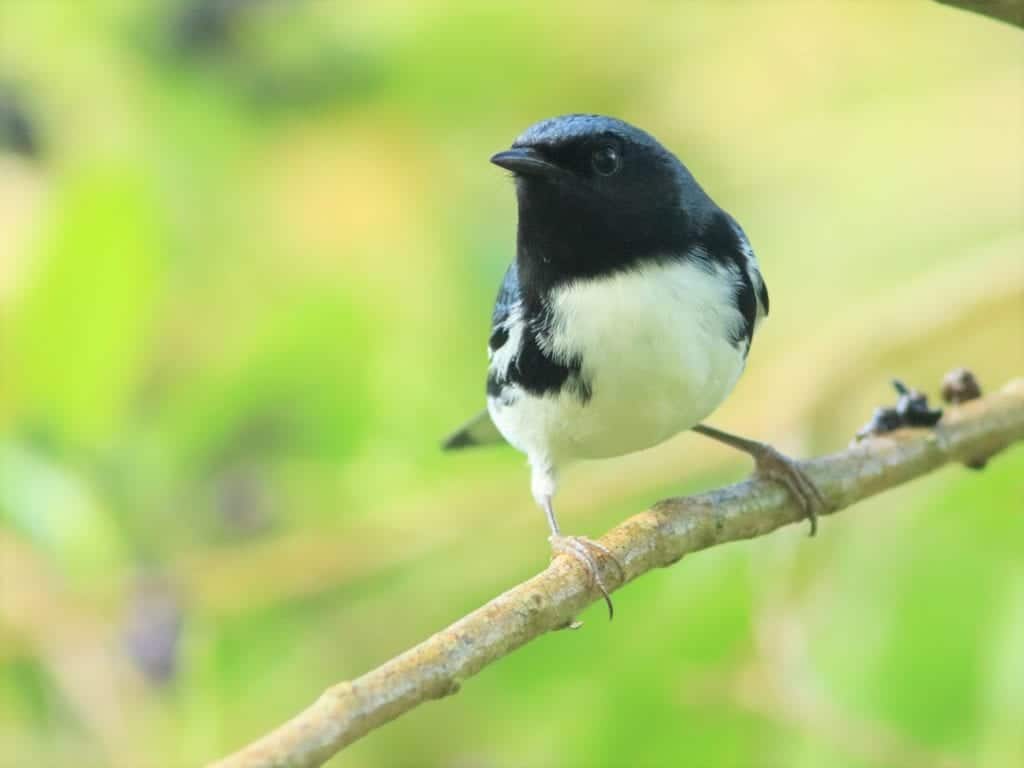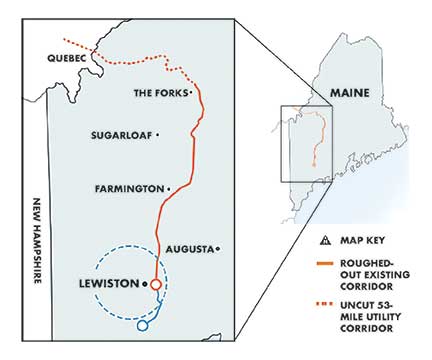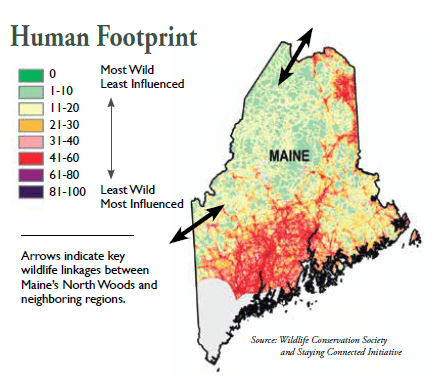
New England Clean Energy Connect (NECEC) is a transmission line proposed to bring electricity from hydro facilities in Quebec to consumers in Massachusetts. In the proposed path of construction for the transmission line lies a 53-mile stretch of undeveloped Maine woods between the Canadian border and The Forks.
Construction of NECEC would carve a 150-foot-wide corridor through these remote woods, part of the largest connected forest in the eastern United States. In the future, the corridor could be as wide as 300 feet. These woods are inhabited by all kinds of iconic Maine wildlife, from grouse to moose to mink to eagle, and are recognized around the world for their biodiversity: the North Woods are the largest globally significant Important Bird Area in the continental U.S., and are considered as an “internationally significant wildlife corridor” and a “highly resilient landscape” by the Staying Connected Initiative and The Nature Conservancy, respectively. This important habitat, critical for so many species, would be forever altered.

Due to the scale of these impacts, Maine Audubon and others have been critical of NECEC and the proposed mitigation plans developed by Central Maine Power (CMP). Throughout the proposal process our staff has met with CMP staff to discuss our concerns and recommend ways the transmission line could avoid, minimize and–once impacts have been avoided and minimized to the greatest extent possible–compensate for its projected impacts.
In late February, Governor Janet Mills signed a “stipulation,” indicating her support for the project. In late March the Maine Public Utilities Commission recommended approval of the project. Additional hearings are taking place this week before the Land Use Planning Commission and the Department of Environmental Protection, but the Mills Administration has thus far sent strong signals in favor of the project.
Maine Audubon feels strongly that the project and its mitigation plan offer unsatisfactory protections for Maine wildlife. In our review of the environmental impacts studies provided by CMP we’ve noticed an absence of consideration of one of the project’s major impacts: habitat fragmentation.

The 53-mile portion of the proposed transmission line would bisect the natural landscape, which can be a problem for species that need large unbroken blocks of habitat. Our review of the proposal found that this portion of the proposed corridor would impact more than 5,000 linear acres of habitat. Some species will be cut off from important pieces of habitat like breeding grounds or high quality feeding areas. Some animals are unable to traverse the opening–think salamanders crossing a dry open right-of-way (ROW) on a hot summer day–while other species will not cross the opening because it makes them vulnerable to predators.
Fragmentation of forested habitat in particular can have long-lasting effects, and when the fragmentation is permanent like the regularly maintained NECEC corridor would be, it can displace entire populations of interior forest species. This is because the impact of the fragmenting feature can reach far into the forest, affecting otherwise intact,neighboring habitats.
Fragmenting a forest changes the characteristics of the forest that remains. More light is able to enter, allowing different plants to grow. Temperatures, hydrology, and wind speeds change. Open-habitat predators or competitors to interior forest species suddenly have access to these species and their resources. Forest fragmentation from transmission lines also often creates hard edges between forest habitats and early successional habitats rather than a more natural transition from grassland to shrubland to forest. It is estimated that even if a fragmenting feature occurs on only 1% of the landscape, it affects up to 18% of the surrounding area. (Forman RTT and Alexander LE (1998) Roads and Their Major Ecological Effects. Annual Review of Ecology and Systematics. 29(1):207-231).
In this series of blog posts we will be examining several Maine species likely to be impacted by the forest fragmentation caused by the proposed corridor. We’ll look at songbirds, including the beautiful Blackburnian Warbler, as well as species that need interior forest and will be impacted by increased predation and disturbance if the corridor is built. Our next post will examine species that need large tracts of unbroken forests, including the American Marten. Next we’ll consider the Wood Turtle, and other species that need protected riparian habitat. Finally, we will use the Northern Spring Salamander to represent “other” species, those likely to be negatively impacted from direct habitat loss, changes in forest cover, and habitat disturbance but for which steps have been taken by CMP to minimize or compensate for impacts.
We hope you’ll join us and continue the conversation about the impacts of this major project in Maine’s North Woods.
